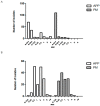Antimicrobial Susceptibility Pattern of Porcine Respiratory Bacteria in Spain
- PMID: 32664493
- PMCID: PMC7400251
- DOI: 10.3390/antibiotics9070402
Antimicrobial Susceptibility Pattern of Porcine Respiratory Bacteria in Spain
Abstract
The monitoring of antimicrobial susceptibility of pig pathogens is critical to optimize antimicrobial treatments and prevent development of resistance with a one-health approach. The aim of this study was to investigate the antimicrobial susceptibility patterns of swine respiratory pathogens in Spain from 2017 to 2019. Bacterial isolation and identification were carried out following standardized methods from samples coming from sacrificed or recently deceased pigs with acute clinical signs compatible with respiratory tract infections. Minimum inhibitory concentration (MIC) values were determined using the broth microdilution method containing a total of 10 and 7-8 antimicrobials/concentrations respectively, in accordance with the recommendations presented by the Clinical and Laboratory Standards Institute (CLSI). The obtained antimicrobial susceptibility varies between pig respiratory pathogens. Actinobacillus pleuropneumoniae (APP) and Pasteurella multocida (PM) were highly susceptible (≥90%) to ceftiofur, florfenicol and macrolides (tilmicosin, tildipirosin and tulathromycin). However, the antimicrobial susceptibility was intermediate (>60% but <90%) for amoxicillin and enrofloxacin in the case of APP and sulfamethoxazole/trimethropim and tiamulin in the case of PM. Both bacteria showed low (<60%) antimicrobial susceptibility to doxycycline. Finally, Bordetella bronchiseptica was highly susceptible only to tildipirosin and tulathromycin (100%) and its susceptibility for florfenicol was close to 50% and <30% for the rest of the antimicrobial families tested. These results emphasize the need of determining antimicrobial susceptibility in pig respiratory cases in order to optimize the antimicrobial treatment in a case-by-case scenario.
Keywords: antimicrobial susceptibility; respiratory pathogens; swine.
Conflict of interest statement
The authors declare no conflict of interest.
Figures





Similar articles
-
Susceptibility trends of swine respiratory pathogens from 2019 to 2022 to antimicrobials commonly used in Spain.Porcine Health Manag. 2023 Oct 19;9(1):47. doi: 10.1186/s40813-023-00341-x. Porcine Health Manag. 2023. PMID: 37858281 Free PMC article.
-
Monitoring of antimicrobial susceptibility of respiratory tract pathogens isolated from diseased cattle and pigs across Europe, 2009-2012: VetPath results.Vet Microbiol. 2016 Oct 15;194:11-22. doi: 10.1016/j.vetmic.2016.04.009. Epub 2016 Apr 14. Vet Microbiol. 2016. PMID: 27102206
-
Mutant prevention and minimum inhibitory concentration drug values for enrofloxacin, ceftiofur, florfenicol, tilmicosin and tulathromycin tested against swine pathogens Actinobacillus pleuropneumoniae, Pasteurella multocida and Streptococcus suis.PLoS One. 2019 Jan 10;14(1):e0210154. doi: 10.1371/journal.pone.0210154. eCollection 2019. PLoS One. 2019. PMID: 30629633 Free PMC article.
-
Antimicrobial susceptibility monitoring of respiratory tract pathogens isolated from diseased cattle and pigs across Europe: the VetPath study.Vet Microbiol. 2014 Aug 6;172(1-2):202-15. doi: 10.1016/j.vetmic.2014.04.008. Epub 2014 Apr 21. Vet Microbiol. 2014. PMID: 24837878
-
Amoxicillin-current use in swine medicine.J Vet Pharmacol Ther. 2018 Jun;41(3):356-368. doi: 10.1111/jvp.12482. Epub 2018 Jan 19. J Vet Pharmacol Ther. 2018. PMID: 29352469 Review.
Cited by
-
A physiologically based pharmacokinetic model to optimize the dosage regimen and withdrawal time of cefquinome in pigs.PLoS Comput Biol. 2023 Aug 16;19(8):e1011331. doi: 10.1371/journal.pcbi.1011331. eCollection 2023 Aug. PLoS Comput Biol. 2023. PMID: 37585381 Free PMC article.
-
Isolates, Antimicrobial Susceptibility Profiles and Multidrug Resistance of Bacteria Cultured from Pig Submissions in New Zealand.Animals (Basel). 2020 Aug 14;10(8):1427. doi: 10.3390/ani10081427. Animals (Basel). 2020. PMID: 32824043 Free PMC article.
-
The Susceptibility Trends of Respiratory and Enteric Porcine Pathogens to Last-Resource Antimicrobials.Antibiotics (Basel). 2023 Oct 28;12(11):1575. doi: 10.3390/antibiotics12111575. Antibiotics (Basel). 2023. PMID: 37998776 Free PMC article.
-
Susceptibility of Actinobacillus pleuropneumoniae, Pasteurella multocida and Streptococcus suis Isolated from Pigs in Hungary between 2018 and 2021.Antibiotics (Basel). 2023 Aug 8;12(8):1298. doi: 10.3390/antibiotics12081298. Antibiotics (Basel). 2023. PMID: 37627719 Free PMC article.
-
Intranasal B5 promotes mucosal defence against Actinobacillus pleuropneumoniae via ameliorating early immunosuppression.Virulence. 2024 Dec;15(1):2316459. doi: 10.1080/21505594.2024.2316459. Epub 2024 Feb 20. Virulence. 2024. PMID: 38378464 Free PMC article.
References
-
- Brockmeier S.L., Halbur P.G., Thacker E.L. Porcine respiratory disease complex. In: Brogden K.A., Guthmiller J.M., editors. Polymicrobial Diseases. ASM Press; Washington, DC, USA: 2002. - PubMed
-
- Van Alstine W.G. Respiratory system. In: Zimmerman J.J., Karriker L.A., Kent A.R., Schwartz J., Stevenson G.W., editors. Diseases of Swine. Wiley-Blackwell; Ames, IA, USA: 2012.
LinkOut - more resources
Full Text Sources
Molecular Biology Databases

